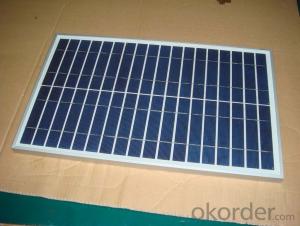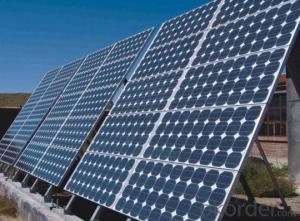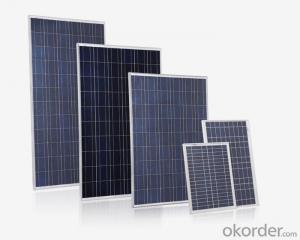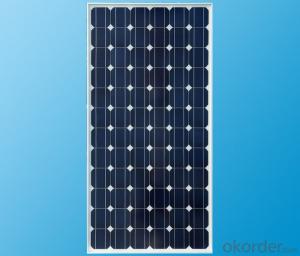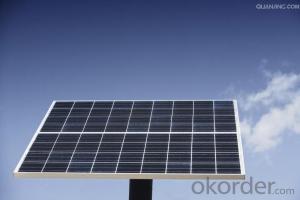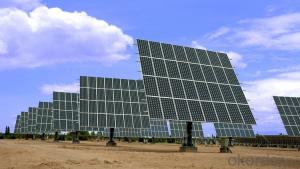solar panel 50w100w150w200w250w300w
- Loading Port:
- China Main Port
- Payment Terms:
- TT OR LC
- Min Order Qty:
- -
- Supply Capability:
- 10000000000000 watt/month
OKorder Service Pledge
OKorder Financial Service
You Might Also Like
Quick Details
| Place of Origin: | Guangdong China (Mainland) | Brand Name: | CAP | Model Number: | 50w100w150w200w250w300w |
| Material: | Monocrystalline Silicon | Size: | 1385*1035*75mm | Number of Cells: | 72pcs |
| Max. Power: | 300w | type: | solar panel | color: | blue&black |
| warranty: | 5 years |
Packaging & Delivery
| Packaging Detail: | standard export package for solar panel |
| Delivery Detail: | 7-15 days for solar panel |
Specifications
solar panel
High Efficiency
25 years Warranty
High-transmissivity low-iron tempered glass
Solar Panel
50w100w150w200w250w300w
Characteristics
1,High and stable conversion efficienly based on over 4 years professional experience
2 ,High reliability with guaranteed +/-10% output power tolerance
3,Proven materials,tempered front glass,and a sturdy anodized aluminum frame allow modules to operate reliably in multiple mountily configurations
4,Combination of high efficicncy and attractive appearance
Quality and Safety
1,25 year 80%,10 year 90% power warranty 3 year power warranty
2,ISO9001:2000 (Quality Management system) certified factory
3,Product Quality warranty & products Liability Insurance to guarantee and user' benefits
4,Certifications TUV Intercert, CE Temperature Coefficients
| Module Type | 100w | 150w | 200w | 250w | 300w |
| Maximum Power at ST(Pmax)W | 100wp | 150wp | 200wp | 250wp | 300wp |
| Maximum Power Voltage(Vmp)V | 36/18 | 36/18 | 36/18 | 30.8v | 36/18 |
| Maximum Power Current(Imp)A | 2.77/5.55 | 4.16/8.33 | 5.55/11.1 | 8.11A | 8.33/16.66 |
| Open Circuit Voltage(Voc)V | 39.5/19.05 | 39.3/19.4 | 39.6/19.5 | 36.2V | 39.6/19.8 |
| Short Circuit Current(Isc)A | 3.04/6.09 | 4.58/9.16 | 6.1/12.2 | 8.7A | 9.16/18.33 |
| Cell Efficiency(%) | 18.60% | 18.10% | 18.60% | 17.80% | 18.10% |
| Module Efficiency(%) | 17.70% | 17.20% | 17.70% | 17.10% | 17.20% |
| Operating Temperature°C | -40°C to +85°C | -40°C to +85°C | -40°C to +85°C | -40°C to +85°C | -40°C to +85°C |
| Maximum system voltage | 1000V(IEC)DC | 1000V(IEC)DC | 1000V(IEC)DC | 1000V(IEC)DC | 1000V(IEC)DC |
| Power tolerance | -0.03 | -0.03 | -0.03 | -0.03 | -0.03 |
| Temperature coefficients of Pmax | -0.45%/°C | -0.45%/°C | -0.45%/°C | -0.45%/°C | -0.45%/°C |
| Temperature coefficients of Voc | -0.27%/°C | -0.27%/°C | -0.27%/°C | -0.27%/°C | -0.27%/°C |
| Temperature coefficients of Isc | 0.05%/°C | 0.05%/°C | 0.05%/°C | 0.05%/°C | 0.05%/°C |
| Weight(kg) | 8 | 11 | 14 | 20 | 25.5 |
| Number of cell(pcs) | 4*9 | 4*9 | 6*10 | 6*12 | 6*12 |
| Dimensions(mm) | 1194*534*35/30 | 1580*808*50/35 | 1471*670*40/35 | 1640*992*50 | 2000*1050*50 |
- Q:Can solar cells be used in desert regions?
- Yes, solar cells can be used in desert regions. In fact, desert regions are ideal for solar energy generation due to their high levels of solar radiation and clear skies. The availability of ample sunlight and vast open spaces make deserts well-suited for large-scale solar power installations, such as solar farms or concentrated solar power plants. Additionally, the arid climate in deserts minimizes the risk of cloud cover or rain interfering with solar energy production.
- Q:Want to use solar panels and batteries to produce a power supply that can provide a stable voltage, how can you connect? Can you connect directly with the solar panel to the battery while the battery power supply is feasible?
- Solar cells and battery connection, it is best to use a photovoltaic charging controller, which can control the output voltage of solar cells can protect the battery is not overcharge, but also at night when the solar cell does not generate electricity, to prevent the battery power back
- Q:Can solar cells be used to power remote sensing devices?
- Yes, solar cells can be used to power remote sensing devices. Solar cells convert sunlight into electricity, providing a reliable and sustainable source of power for remote sensing devices in areas where traditional power sources may be unavailable or impractical. This enables continuous operation of these devices, allowing for data collection and monitoring in remote locations.
- Q:How do solar cells perform in tropical climates?
- Solar cells perform well in tropical climates due to the abundance of sunlight and high temperatures. The intense sunlight provides optimal conditions for solar energy generation, allowing the cells to produce electricity efficiently. However, the high temperatures can cause some decrease in performance, as solar cells are sensitive to heat. Proper maintenance and cooling techniques can mitigate this issue and ensure consistent performance. Overall, solar cells are highly effective in tropical climates and can play a significant role in meeting the energy demands of these regions.
- Q:How do solar cells perform in areas with high levels of bird droppings?
- Solar cells may experience a decrease in performance in areas with high levels of bird droppings. The droppings can create a layer of dirt and debris on the surface of the solar cells, reducing their efficiency in converting sunlight into electricity. Regular cleaning and maintenance are necessary to ensure optimal performance in such areas.
- Q:What is the efficiency of solar cells?
- The efficiency of solar cells refers to the percentage of sunlight that can be converted into usable electricity. It varies depending on the type of solar cell technology used, but current commercial solar cells typically have an efficiency range of 15% to 22%. However, research and development efforts are continuously improving solar cell efficiency, with some laboratory prototypes achieving efficiencies exceeding 40%.
- Q:What is the impact of solar cell installations on job creation?
- The impact of solar cell installations on job creation is significant. The growing demand for renewable energy has created a surge in the solar industry, leading to the creation of numerous job opportunities. Solar cell installations require skilled workers for design, installation, maintenance, and manufacturing, resulting in a wide range of employment opportunities across various sectors. Moreover, the shift towards solar energy creates a ripple effect, stimulating the local economy and supporting job growth in related industries such as construction, engineering, and manufacturing of solar components. Overall, solar cell installations have a positive impact on job creation by fostering a sustainable and green workforce.
- Q:Can solar cells be used for powering remote sensors?
- Yes, solar cells can be used for powering remote sensors. Solar cells convert sunlight into electricity, making them a reliable and sustainable source of power for remote applications. They are commonly used to provide continuous power to sensors in remote locations, where access to the electrical grid may be limited or non-existent.
- Q:How do solar cells affect air pollution?
- Solar cells help reduce air pollution by producing electricity without emitting harmful pollutants or greenhouse gases. Traditional energy sources such as coal, oil, and gas power plants release pollutants like sulfur dioxide, nitrogen oxide, and carbon dioxide, contributing to air pollution and climate change. Solar cells, on the other hand, convert sunlight directly into electricity, generating clean and renewable energy. This reduces the need for fossil fuel-based electricity generation, thereby reducing air pollution and improving air quality.
- Q:How do solar cells perform in areas with high levels of light pollution?
- Solar cells do not perform as efficiently in areas with high levels of light pollution. The excessive artificial light can interfere with the ability of solar cells to absorb and convert sunlight into electricity. This results in reduced power output and lower overall performance of the solar cells.
1. Manufacturer Overview |
|
|---|---|
| Location | |
| Year Established | |
| Annual Output Value | |
| Main Markets | |
| Company Certifications | |
2. Manufacturer Certificates |
|
|---|---|
| a) Certification Name | |
| Range | |
| Reference | |
| Validity Period | |
3. Manufacturer Capability |
|
|---|---|
| a)Trade Capacity | |
| Nearest Port | |
| Export Percentage | |
| No.of Employees in Trade Department | |
| Language Spoken: | |
| b)Factory Information | |
| Factory Size: | |
| No. of Production Lines | |
| Contract Manufacturing | |
| Product Price Range | |
Send your message to us
solar panel 50w100w150w200w250w300w
- Loading Port:
- China Main Port
- Payment Terms:
- TT OR LC
- Min Order Qty:
- -
- Supply Capability:
- 10000000000000 watt/month
OKorder Service Pledge
OKorder Financial Service
Similar products
New products
Hot products
Related keywords
